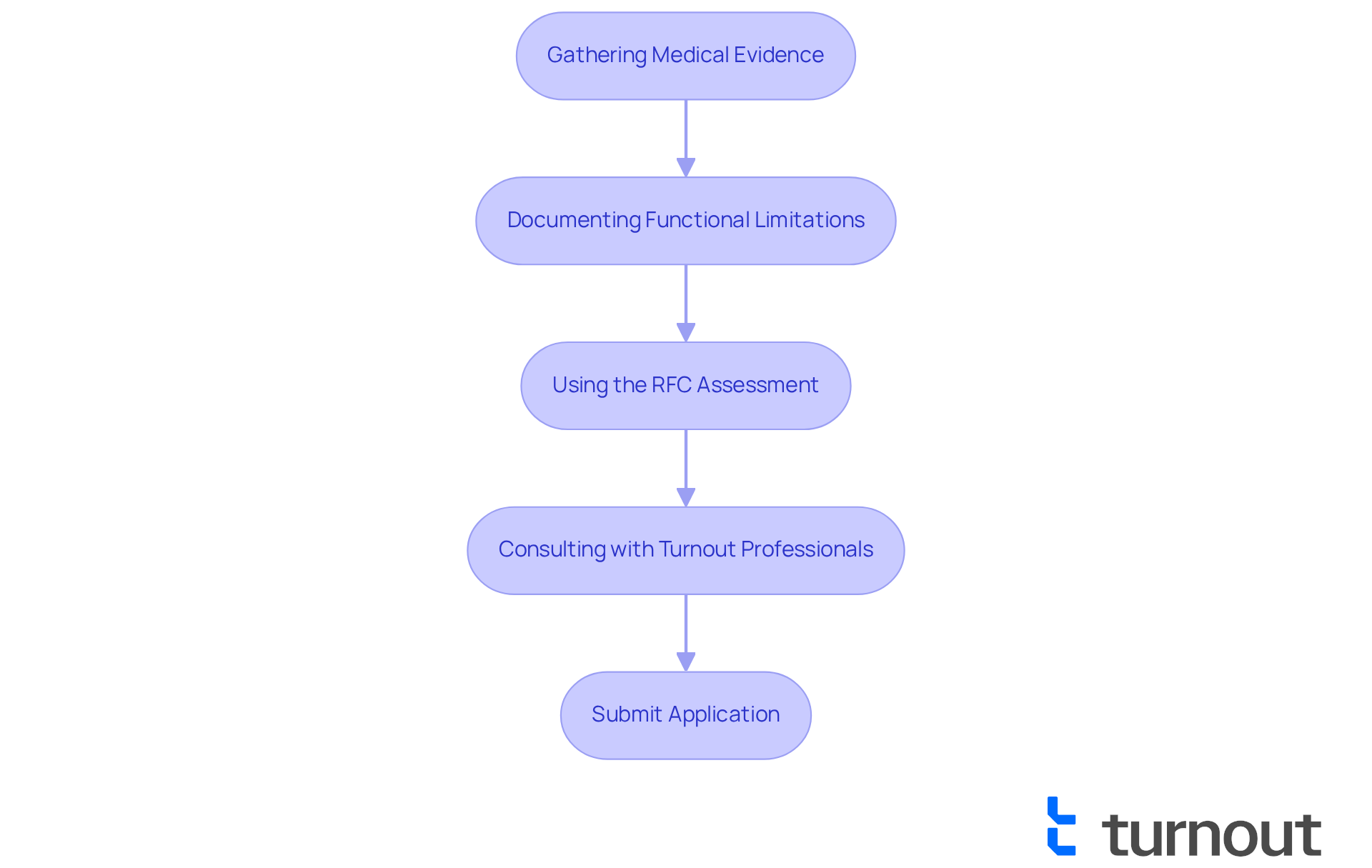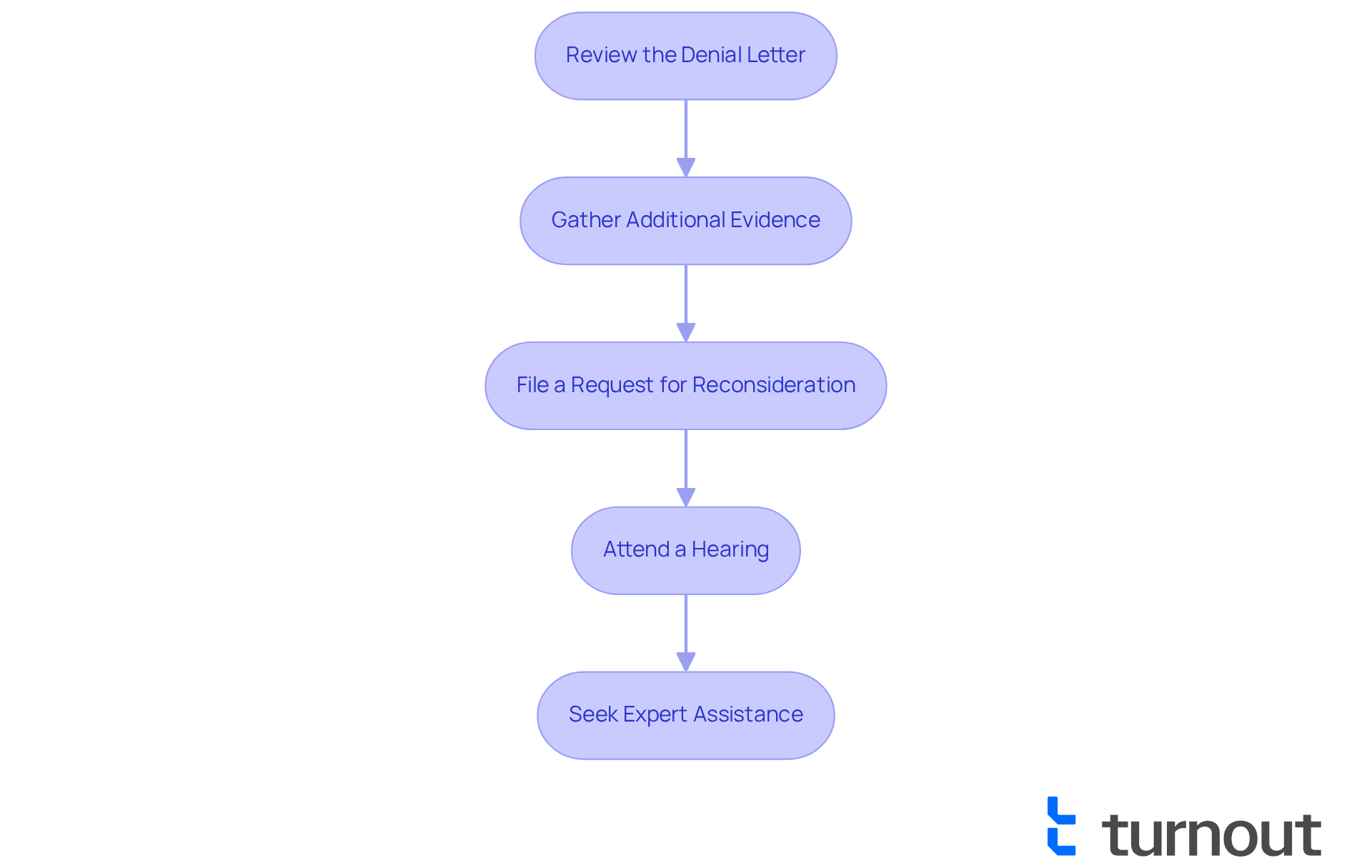Overview
Navigating the world of Social Security listings can feel overwhelming, especially when you're seeking disability benefits. We understand that this journey is often filled with uncertainty and concern. That’s why it’s essential to grasp the significance of these listings. They serve as a structured framework for evaluating medical conditions that qualify individuals for benefits.
These listings streamline the application process, allowing those whose conditions meet the criteria to qualify without the added burden of proving their inability to work. This can be a relief for many, as it simplifies a complex system. Familiarity with these listings is crucial for potential beneficiaries, as it empowers you to take the necessary steps toward securing the support you need.
Remember, you are not alone in this journey. Many have walked this path and found success by understanding how these listings work. We’re here to help you navigate this process with compassion and care. Take the time to learn about the listings; it could make all the difference in your application experience.
Introduction
Navigating the complexities of Social Security listings can feel overwhelming, especially when you're seeking disability benefits. We understand that these listings are not just a set of criteria; they represent a vital pathway to the financial support you may need. They can also simplify the application process for those whose medical conditions align with specific requirements.
But with recent updates and numerous categories to consider, how can you effectively present your case? This article aims to shed light on the significance of Social Security listings, explore the various categories of impairments, and outline the steps you can take when applying or appealing for benefits.
You're not alone in this journey. Together, we’ll provide a comprehensive guide to help you secure the support you deserve.
Define Social Security Listings and Their Importance
Social security listings are more than just a set of criteria; they serve as a lifeline for many. Created by the Social Security Administration (SSA), the social security listings outline medical issues serious enough to prevent someone from engaging in substantial gainful activity. They’re organized by body systems and detail the medical findings necessary for eligibility. Understanding these listings is essential. They serve as a benchmark for evaluating disability claims, and if your condition meets or equals the social security listings, you may qualify for benefits without needing to prove that you can't work in any job. This streamlined process can significantly ease the burden of securing support.
We understand that navigating this system can be overwhelming. Recent updates to the catalog have refined the criteria, ensuring they align with current medical standards and practices. For example, the introduction of expiration dates for certain listings requires periodic reviews, helping to maintain their relevance and accuracy. In 2023, approximately 10.6 million people aged 18-64 received payments due to their own disabilities, many qualifying through these categories.
Real-world experiences highlight the importance of understanding Social Security criteria. Many individuals who have successfully maneuvered through the application process often cite their knowledge of the directory as a key factor in their acceptance. Experts agree that these criteria not only expedite the claims process but also ensure that those with legitimate disabilities receive the support they need. Considering that Social Security benefits account for more than half of the earnings for about 64% of recipients, grasping these criteria is vital for anyone seeking financial assistance through the program.
Remember, you are not alone in this journey. We’re here to help you navigate these complexities and find the support you deserve.

Explore Categories of Impairments in Social Security Listings
The social security listings classify impairments into 14 distinct groups, with each group representing a specific body system or type of disability. These categories include:
- Musculoskeletal Conditions: Issues influencing bones, joints, and muscles, including arthritis and back ailments.
- Special Senses and Speech: Impairments related to vision, hearing, and speech.
- Respiratory Issues: Conditions like asthma and chronic obstructive pulmonary disease (COPD).
- Cardiovascular System: Heart-related conditions, including heart failure and coronary artery disease.
- Digestive System: Conditions impacting the gastrointestinal tract, such as inflammatory bowel disease.
- Genitourinary Conditions: Issues affecting the urinary and reproductive systems.
- Hematological Conditions: Blood issues, including anemia and clotting abnormalities.
- Skin Conditions: Issues impacting the skin, such as psoriasis and dermatitis.
- Endocrine Issues: Issues such as diabetes and thyroid ailments.
- Neurological Conditions: Conditions affecting the nervous system, including epilepsy and multiple sclerosis.
- Mental Conditions: A variety of psychological issues, such as depression and anxiety conditions.
- Cancer: Various types of cancer and their treatment effects.
- Immune System Conditions: Situations that weaken the immune system, such as HIV/AIDS.
- Congenital Disorders: Conditions present at birth that affect bodily functions.
Each category has specific criteria that must be met, including social security listings, medical documentation, and test results. For instance, musculoskeletal disorders are evaluated based on their impact on mobility and daily functioning. It’s important to recognize that evidence must show that a limitation has persisted or is anticipated to persist for at least 12 uninterrupted months to be eligible for assistance.
The Listings are divided into two parts: Part A applies to adults aged 18 and over, while Part B is used for evaluating disabilities in children under 18. Recent updates to the social security listings have refined the disability categories, ensuring they reflect current medical understanding and practices.
Understanding these categories is essential for assessing eligibility for assistance. We’re here to simplify this process, offering guidance and support to help you navigate the application for Social Security assistance. For example, individuals with severe arthritis may qualify under musculoskeletal disorders, while those with chronic respiratory issues might find their ailments categorized under respiratory disorders. Familiarizing yourself with these categories can greatly assist you on your path toward receiving the benefits you deserve.

Guide to Applying for Benefits with Non-Listed Conditions
If your situation isn’t included in the social security listings, don’t worry—you can still apply for benefits. You just need to show that your impairment is functionally comparable to a recognized issue. Here’s how:
- Gathering Medical Evidence: Start by collecting comprehensive medical records. This includes your diagnoses, treatment history, and test results that illustrate the severity of your health issue.
- Documenting Functional Limitations: Clearly outline how your circumstances limit your ability to perform daily activities and work-related tasks. Think about your physical, mental, and social limitations.
- Using the RFC Assessment: The Residual Functional Capacity (RFC) assessment evaluates what you can still do despite your impairments. It’s crucial to provide detailed information about your limitations to support your claim.
- Consulting with Turnout Professionals: Consider working with Turnout's trained nonlawyer advocates. They can help you present your case effectively, ensuring that all pertinent information is included in your application. This increases your chances of obtaining assistance. Just remember, Turnout is not a legal practice and does not offer legal representation.
By following these steps and utilizing Turnout's guidance, you can enhance your application for support concerning social security listings, even if your condition isn’t specifically mentioned. Remember, you’re not alone in this journey—we’re here to help.

Navigate the Appeals Process for Denied Disability Claims
If your disability claim is denied, don’t lose hope. We understand how disheartening this can be, but remember, the appeals process is here for you to challenge that decision. Here’s how to navigate it:
- Review the Denial Letter: Take a moment to understand the reasons for the denial. This letter outlines the specific criteria that weren’t met, giving you clarity on what to address.
- Gather Additional Evidence: If you can, collect new medical evidence or documentation that speaks to the reasons for the denial. This might include updated medical records or additional statements from your healthcare providers.
- File a Request for Reconsideration: This is your first step in the appeals process. You can submit your request online or by mail, along with any new evidence you’ve gathered.
- Attend a Hearing: If your request for reconsideration is denied, you can ask for a hearing before an administrative law judge. Prepare thoroughly for this hearing; it’s your chance to present your case in person.
- Seek Expert Assistance: Consider working with a disability support advocate. They can help you navigate the appeals process, ensuring you present your case effectively and understand your rights.
By following these steps, you can effectively challenge a denial and work towards securing the benefits you deserve. Remember, you are not alone in this journey; we’re here to help.

Conclusion
Understanding Social Security listings is crucial for anyone seeking disability benefits. These criteria serve as a pathway to essential financial support for those unable to work due to serious medical conditions. We understand that navigating this process can feel overwhelming, but familiarizing yourself with the listings can help you manage the application process more effectively and increase your chances of receiving the assistance you need.
This article has explored the significance of social security listings, detailing the 14 categories of impairments that the Social Security Administration uses to evaluate claims. Each category has specific criteria that applicants must meet. Understanding these nuances can make a significant difference in your application outcome. For those with non-listed conditions, we provided a comprehensive guide on how to document impairments and utilize the RFC assessment to demonstrate eligibility.
Ultimately, the importance of social security listings extends beyond mere bureaucratic criteria; they represent a vital support system for millions facing health challenges. Whether you're navigating the initial application or the appeals process after a denial, having the right knowledge and resources can empower you to advocate for your rights and secure the benefits you deserve. Remember, you are not alone in this journey. Taking proactive steps to understand these listings and seeking assistance can lead to a more manageable and hopeful path forward.
Frequently Asked Questions
What are social security listings?
Social security listings are criteria established by the Social Security Administration (SSA) that outline medical issues serious enough to prevent someone from engaging in substantial gainful activity. They are organized by body systems and detail the necessary medical findings for eligibility.
Why are social security listings important?
They serve as a benchmark for evaluating disability claims. If an individual's condition meets or equals the social security listings, they may qualify for benefits without needing to prove they can't work in any job, simplifying the process of securing support.
How do recent updates affect social security listings?
Recent updates have refined the criteria to align with current medical standards. For instance, the introduction of expiration dates for certain listings necessitates periodic reviews to maintain their relevance and accuracy.
How many people receive benefits through social security listings?
In 2023, approximately 10.6 million people aged 18-64 received payments due to their own disabilities, many of whom qualified through these listings.
How can knowledge of social security listings impact the application process?
Individuals who understand the social security listings often find that their knowledge is a key factor in their acceptance during the application process, as it helps expedite claims and ensures legitimate disabilities receive support.
What is the significance of Social Security benefits for recipients?
Social Security benefits account for more than half of the earnings for about 64% of recipients, making it vital for anyone seeking financial assistance to grasp these criteria.




